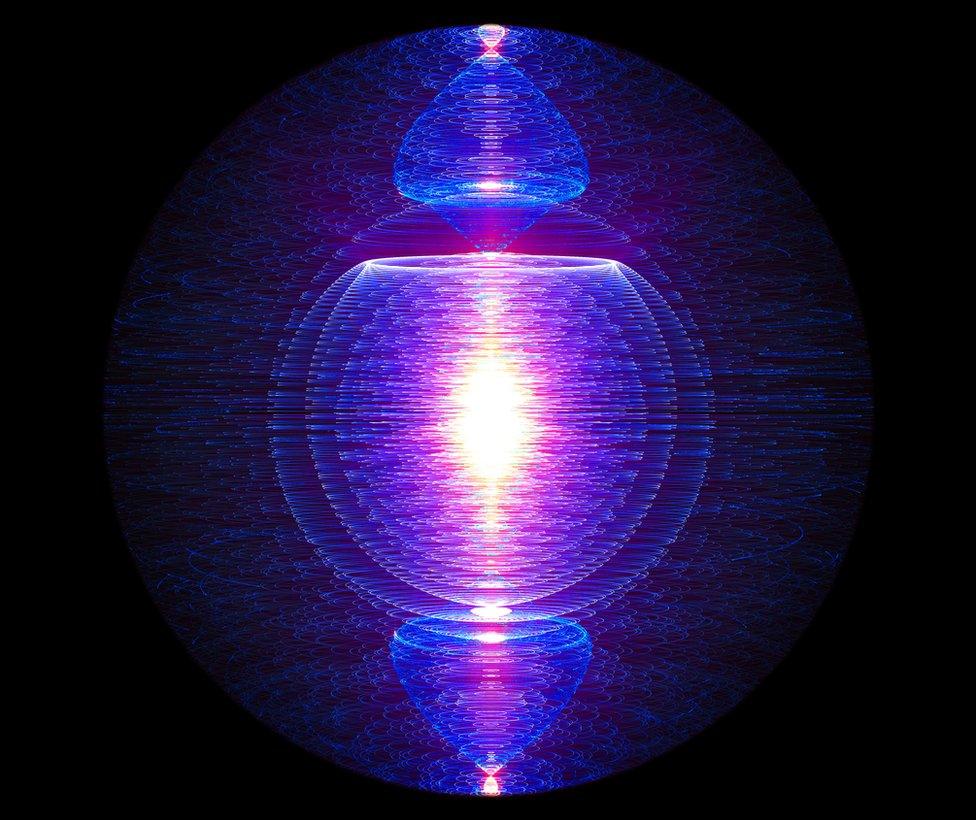Nuclear fusion is 'a question of when, not if'
- Published
- comments

An artist's impression of how a fusion reactor might look
The prospects for developing nuclear fusion as a feasible source of energy have significantly improved, say experts.
The UK government has recently announced an investment of £200m to deliver electricity from a fusion reactor by 2040.
Private companies and governments have told the BBC they aim to have demonstration models working within five years.
But huge hurdles remain, say critics.
With the price of wind and solar continuing to drop, experts say these existing renewables might offer a more economical and timely method of tackling climate change and generating energy than an unproven technology like fusion.
Nuclear fusion is an attempt to replicate the processes of the Sun on Earth. It differs significantly from nuclear fission, which has been our only way of getting electricity from atoms since the 1950s.
Fission has proven to be hugely expensive. It generates large amounts of radioactive waste and raises serious concerns about safety and the proliferation of weapons.
So what exactly is fusion?
Fusion is the process that drives our Sun.
Every single second, millions of tonnes of hydrogen atoms crash together in the tremendous temperatures and pressures of our parent star. This forces them to break their atomic bonds and fuse to make the heavier element, helium.

The giant Iter site in southern France aims to have its first plasma generated in 2025
Natural, solar fusion generates enormous quantities of heat and light.
For decades, researchers have been trying to replicate this process on Earth, or "build the Sun in a box" as one physicist dubbed it. The basic idea is to take a type of hydrogen gas, heat it to more than 100 million degrees until it forms a thin, fragile cloud called a plasma, and then control it with powerful magnets until the atoms fuse and release energy.
Potentially, it can generate power that is low carbon, with much smaller amounts of waste. It also comes without the danger of explosions.
To deliver the fusion concept, countries have focused their energies on a major international co-operative effort called Iter.
Giant step forward or a white elephant?
The Iter project involves 35 countries and, right now, it is constructing a huge test reactor in southern France.
The plan is to have the first plasma generated in 2025. However, getting from this step to producing energy is extremely difficult.
Iter has also been beset by long delays and budget overspend which means it is unlikely to have a demonstration fusion power plant working even by 2050.
"One of the reasons that Iter is late is that it is really, really hard," said Prof Ian Chapman, chief executive of the UK Atomic Energy Authority.
"What we are doing is fundamentally pushing the barriers of what's known in the technology world. And of course you reach hurdles and you have to overcome them, which we do all the time and Iter will happen, I am completely convinced of it."

General Fusion believe their approach to fusion will work within five years
Until Iter is up and running in 2025, the UK based Joint European Torus (Jet) remains the world's largest fusion experiment.
It has secured EU funding until the end of 2020, but what happens after that, and the participation of the UK in Iter after Brexit remain unclear.
To give some sense of certainty, the UK government recently announced £220m, external for the conceptual design of a fusion power station by 2040.
Over the next four years, researchers based at Culham in Oxfordshire will develop designs for a fusion power plant called Step or Spherical Tokomak for Energy Production.
How will the UK make fusion work?
The most widely known approach to making fusion happen involves a doughnut shaped vacuum chamber called a Tokomak. Hydrogen gas is heated to 100 million degrees C at which point it become a plasma. Powerful magnets are used to confine and steer the plasma until fusion occurs.
In the UK, researchers have developed a different form of Tokamak, that more resembles an apple core than a doughnut. Called a Spherical Tokamak, it has the advantage of being more compact, potentially allowing future power plants to be located in towns and cities.
"If you look at some of the very big units, the big machines that we are looking at, just finding geographically somewhere to put them is difficult," said Nanna Heiberg from the UK Atomic Energy Authority.
"What you really want to do is put them close to where the energy is required. And so if you can do them in a much smaller footprint, you can put them closer to the users and you can put more of them around the country for example."
So where is the excitement about fusion coming from?
While governments are wrestling with Iter, many are also driving ahead with their own national plans. China, India, Russia and the US among others are working on developing commercial reactors.

Building the "sun in a box" has remained outside the grip of scientists for decades
As well as the UK government putting cash in, the European Investment Bank is pumping hundreds of millions of euros into an Italian programme to produce fusion energy by 2050.
But perhaps the major excitement comes from private companies. They are usually smaller, nimbler, and they develop by making mistakes and learning from them quickly.
There are now dozens of them around the world, raising funds and pushing forward often with different approaches to fusion than that seen in Iter and in the UK.
Here's a brief sample of some different approaches to fusion.
First Light:, external This company originated in the University of Oxford and was founded specifically to address the urgent need to decarbonise the global energy system. Their idea involves firing a projectile at a target that contains hydrogen atoms. The shockwave from the impact of the projectile creates a shockwave that crushes the fuel and briefly this reaction will produce plasma that is hotter than the sun and denser than lead.
Commonwealth Fusion System, externals: A private company created by former Massachusetts Institute of Technology (MIT) staff, CFS has raised significant funding of over $100m. It is focusing on developing a Tokamak system but its key innovation is in superconducting magnets. They hope to build powerful enough magnets so they can build smaller and cheaper Tokomaks to contain the plasmas required to generate fusion.
TAE Technologies:, external With backing from Google and other high tech investors, this California-based company is using a different mix of fuel to develop smaller, cheaper reactors. They want to use hydrogen and boron as both elements are readily available and non-radioactive. Their prototype is a cylindrical colliding beam fusion reactor (CBFR) that heats hydrogen gas to form two rings of plasma. These are merged and held together with beams of neutral particles to make it hotter and last longer.
US Navy, external: Worried about how to power their ships in the future, the US Navy has filed a patent for a "plasma compression fusion device". The patent says that it would use magnetic fields to create "accelerated vibration and/or accelerated spin". The idea would be to make fusion power reactors small enough to be portable. There's a lot of scepticism that this approach will work.
'A ball of liquid metal...'
One of the main challengers with ambitions to make fusion work is a company based in British Columbia, Canada called General Fusion, external. Their approach, which has gathered a lot of attention and backing from the likes of Amazon's Jeff Bezos, combines cutting edge physics with off the shelf technology.
They call their system "magnetised target fusion".
This approach sees a hot gas plasma injected into a ball of liquid metal inside a steel sphere. It is then compressed by pistons, much like in a diesel engine.
"The pistons all fire simultaneously and collapse the cavity with the fuel inside," said Michael Delage, the company's chief technology officer.
"So at the peak of that compression when the fuel bursts into fusion reaction, it is surrounded on all sides by liquid metal so the energy goes into the metal and you take this hot liquid metal and boil water, make steam and make electricity."
General Fusion say they hope to have a working model within five years.
Why hasn't fusion worked so far?
Despite the hopes, no one to date has managed to get more energy out of a fusion experiment than they have put in.
Most experts are confident the idea will work, but many believe that it is a matter of scale. To make it work, you have to go large.
"I think fusion needs resources to really make it work," said Prof Ian Chapman from UKAEA. "You could do that within a company or a country but you really need to have the requisite scale and resources."

The compression system for the General Fusion reactor featuring large scale pistons
"When ITER works, and I say when, not if, it will be a step change for fusion and you will see massive investment come into the field."
Will renewable energy make fusion redundant?
In 2018, the IPCC reported that emissions of carbon dioxide need to be reduced by 45% by 2030 to keep the rise in global temperatures under 1.5C.
Getting to that point requires a rapid decarbonisation of the energy sector. The UK has committed to Net Zero emissions by 2050 which will require the deployment of wind and solar on a massive scale. Some argue this is should be a greater priority for Britain, rather than spending large sums on experimental fusion reactors.
"The cost of renewables has shot down while the cost of the world fusion project, Iter has gone up and it now looks very unlikely they will be able to compete without new ideas," said Sir Chris Llewellyn Smith, a one time chair of the ITER council and a respected British physicist.
"I don't think this means we should give up on fusion, there are ways it could become cheaper but it is not going to be there immediately when we need in the UK at least."
Others involved in the fusion industry take a different view.
"If you're a country like Malaysia, that has a high carbon intensity of its energy system, and you're trying to move away from coal, there's not a lot of options today," said Chris Mowry, General Fusion's chief executive.
"This is the type of application we're focused on. And even in countries like Canada, which have a fair amount of renewables, it can never be 100% renewables."
"And so we need a carbon free source of energy that can complement renewables in the future."
Follow Matt on Twitter., external